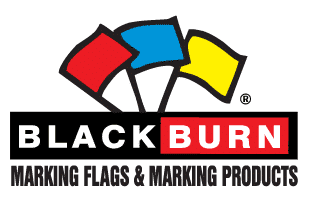Marking flags are everywhere, and we wouldn’t be surprised to find out that many people disregard them as unimportant little colorful things that serve little value to their personal lives. However, we’re here to tell you that marking flags, and specifically field flags, are much more important than they seem, especially in the world of agriculture.
There are many uses for marking flags, and in several important industries, they are absolutely essential to ensuring that work is done correctly and safely.
On and near construction sites (where most of us have probably walked by marking flags), flagging the area properly prevents injuries, confusion and helps the work get done as smoothly as possible.
Marking flags are even used by scuba divers to mark where they are underwater so that other divers and boats know that someone is diving in that location. Super important for diver safety!
In agriculture, the industry that is incredibly important to our daily life, farmers are strongly encouraged to use field flags for safety and to avoid the costly loss of crops.
Why Field Flags and What Do They Mean?
Farmers use various brightly colored flags to distinguish between herbicide-tolerant crops. Having a system to differentiate what crops can handle certain herbicides greatly reduces the chances of an entire harvest being destroyed. It is very easy for an herbicide to damage crops, which is why the Flag the Technology (FTT) program, developed at the University of Arkansas, has been growing in popularity across the United States.
The FTT program simply calls for the use of a colored-coded system of flags placed at the entry points of fields to represent the herbicides specific crops are sensitive to. This system helps applicators to stay aware of what herbicides can be used on the crops they are spraying and on the crops that are adjacent to them to prevent crop injury from herbicide drift.
These are the flag colors used in the FFT program and their meaning *1:
RED
Signifies conventional varieties with no herbicide technology traits.
WHITE
Represents the Roundup Ready™ technology that is tolerant to glyphosate or Roundup® herbicide.
BRIGHT GREEN
Indicates the Liberty Link™ technology. This technology is tolerant to glufosinate (Liberty®) herbicide.
BRIGHT YELLOW
Is the color chosen for Clearfield™ rice technology and STS™ soybeans.1 A yellow flag in a grain sorghum field denotes tolerance to Inzen™ brand grain sorghum from DuPont. This sorghum will tolerate Zest® herbicide; its active ingredient is nicosulfuron.
TEAL
Indicates tolerance to both 2,4-D and FOP (ACCase) herbicides or the Enlist™ technology.
BLACK/CHECKERED
Indicates tolerance to dicamba herbicide or Xtendimax®/Engenia®. The black and white checks indicate tolerance to both dicamba and glyphosate.
PURPLE
Indicates Provisia™ rice from BASF which will tolerate Provisia® herbicide.
Get Agriculture Field Flags from Blackburn Manufacturing
The importance of field flags in agriculture cannot be overstated. The use of this simple color-coded system saves farmers from losing thousands of dollars in destroyed crops.
Blackburn Manufacturing makes long-lasting agriculture field flags that are available in a variety of sizes and include plain, printed, and reflective pennant options.
- Scott, B., Spradley, P., & Baker, R. (n.d.). Flag the Technology. University of Arkansas. Retrieved August 18, 2022, from chrome-extension://efaidnbmnnnibpcajpcglclefindmkaj/https://www.uaex.uada.edu/publications/pdf/FSA-2162.pdf















